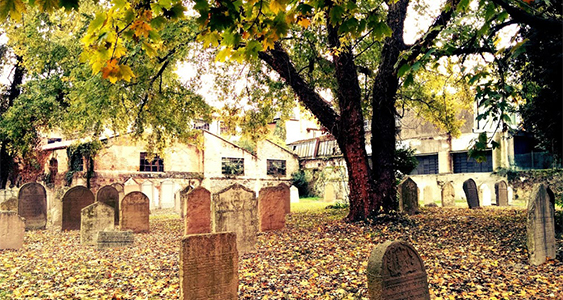Closed to the public: Sunday, April 13 – Monday, April 14 – Sunday, April 20
Looking for a unique and special gift? Surprise your friends and family with an unforgettable cultural experience: a visit to the Jewish Heritage of Padua!
Choose from different visit options all including a guided tour:
✅ GIFT VOUCHER | One site: choose among Museum, Synagogue, Cemetery.
✅ GIFT VOUCHER | Two sites: a richer tour experience.
✅ GIFT VOUCHER | Three sites: discover the entire Jewish Heritage of Padua.
✅ GIFT VOUCHER | Special event: entrance to one of the Museum monthly events.
✅ GIFT VOUCHER | Book voucher: redeemable at the Museum bookstore.
The gift card is valid for one year from the date of issue. The entrance to the Heritage can be booked according to the recipient’s needs.
.
Personalize your gift! Contact us to create a tailor-made present. The best gift: culture, history and emotions at the Jewish Heritage of Padua.
Give a special gift.

The Synagogue
of Italian rite
The Italian rite Synagogue is undoubtedly among the must-visit places in Padua. Founded in 1548, still in use, embellished with elegant eighteenth-century furnishings.
Guided Tour
and multimedia experience
Guided tours to accompany you in the visit of the Museum, Italian Synagogue, and the ancient Jewish Cemeteries of the city. The arches of the matroneum become a canvas for an immersive multimedia experience.

Presented at the ticket office of the Eremitani Museum you will be entitled to a reduction on the entrance ticket to the Civic Museums of Padua

Founded in 1384, the cemetery located along Via Wiel represents one of the four Jewish cemeteries still present in the city of Padua. This ancient sacred place retains its historical significance intact and hosts the tombs of prominent figures of the local Jewish community.
Among these stand out Rabbi Meir Katzenellenbogen (Maharam), his son Samuel Judah Katzenellenbogen, as well as the doctors Abram Catalan and Moshe David Valle.

In the heart of the historic center of Padua and in the ancient ghetto stands the museum that tells the history and traditions of the local Jewish Community, from its inception to the present day.
The structure is housed in the first and largest Ashkenazi Synagogue, founded in 1522 and remained active until May 1943, when it was set on fire by a group of Paduan fascists.

The Italian Synagogue (1548) is still the prayer site for the members of the Community of Padua. The hall is marked out by the elegant and refined “marmorino” decorations and delicate stucco works dating back to neoclassic times.
The Aron Kodesh, made of polychrome marbles, on the eastern wall faces the Bimah, crafted from wood of a century-old tree felled by a storm in the Botanical Garden of the city.

A very old story is narrated through these narrow and restricted streets: the story of the Jewish settlement, its commercial, social, cultural and religious past.
Four gates closed the Ghetto: a sign on one of them forbade Jews as well as Christians to go through the gates at night.

Within the museum, visitors can experience a multimedia journey thanks to the immersive video installation by director Denis Brotto, which allows them to delve into the lives of ten prominent figures from the history of the Paduan Jewish community
You can dive into the life of ten illustrious characters of Padua Jewish life. The characters come to life to narrate their stories through the places representing Padua Judaism.

The Stumbling Stones, laid in the pavement in memory of the victims of Nazi-Fascism, many of which are also visible in the 'ghetto'
In front of the victim's last residence stands a block of stone covered with a brass plate engraved with the name of the deported person, year of birth, date, place of deportation, and, if known, the date of death.
Fill in the form and we will be happy to answer you
For reservations or information, fill out the form and we will be happy to respond